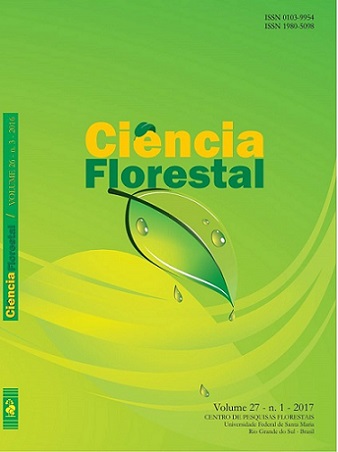IMPORTANCE VALUE INDEX OF TREE SPECIES OF TAPAJÓS NATIONAL FOREST BY ANALYSIS OF PRINCIPAL COMPONENTS AND FACTORS
DOI:
https://doi.org/10.5902/1980509826446Keywords:
phytosociology, forest inventory, cluster sampling.Abstract
Principal components and factor analysis were used to evaluate the applicability of the linear model IVI = a1Ar + a2Dr + a3Fr for obtaining indexes of value of importance (IVI) for tree species, where Ar is relative abundance, Dr is the relative dominance and Fr is the relative frequency, to compare with the standard univariate method that considers a1 = a2 = a3 =1. The data comprised a sample of 104.04 ha, located in Tapajós National Forest, Belterra municipality, state of Pará, covering of a set of 36 clusters of 4 ha each, Malta croos-shaped, with four subplots of 1ha each. To obtain the IVI’sby species within each cluster, each subplot was subdivided each into 5 sub-subplots of 0.2 ha each. The analysis revealed that the values obtained by multivariable differ from those obtained by the standard equation. It was also found that the values of univariate and multivariate indices vary significantly within the forest, and therefore are not recommended, as they usually are, to infer a single value for the whole forest area, because species considered of minor importance for the overall forest may be of great importance in particular subareas. The use of linear model with a1 = a2 = a3 =1i s not suitable, because of the wide variation of the coefficients among species and their spatial distribution in the forest.Downloads
References
BARTLETT, M. S. A note on multiplying factors for various chi-squared approximations. Jornal of the Royal Statistical Society, London, v. 16, p. 296-298, 1954.
CAIN, S. A. et al. Application of some phytosociological techniques to Brazilian rain forest. American Journal of Botany, New York, v. 43, p. 911-941, 1956.
CORRAR. L. J.; PAULO, E.; DIAS FILHO, J. M. Análise multivariada para os cursos de administração, ciências contábeis e economia. São Paulo: Atlas, 2007. 344 p.
CRONBACH, L. J. Coefficient alpha and the internal structure of tests. Psychometrika, London, v. 16, n. 3, p. 297-334, 1951.
Curtis, J. T.; MCINTOSH, R. P. The interrelations of certain analytic and synthetic phytosociological characters. Ecology, Washington, v. 31, p. 434-455, 1950.
FÁVERO, L. P. et al. Análise de dados: modelagem para análise de dados. Rio de janeiro: Elsevier, 2009. 646 p.
FINOL, U. H. Nuevos parametros a considerarse en el analysis estructural de Las Selvas Virgenes Tropicales. Revista Forestal Venezolana, Mérida, v. 14, p. 29-42, 1971.
HAIR JUNIOR, J. F. et al. Ensaio sobre la Estructura Florística de la Parte Sub-Oriental del Bosque Universitário “El Caimital” Estado Barinas. Revista Forestal Venezolana, Mérida, v. 7, n. 10-11, p. 77-119, 1964.
LAWLEY, D. N. The estimation of factor looding by the method of maximum likelihood. Proceedings of the Royal Society of Edinburgh, Edinburgh, v. 60, p. 64-82, 1940.
MAROCO, J. Análise estatística com utilização do SPSS. 3. ed. Lisboa: Edições Sílabo, 2007. 824 p.
MINGOTI, S. A. Análise de dados através de Métodos de Estatística Multivariada: uma abordagem aplicada. Belo Horizonte: UFMG, 2005. 300 p.
PEREIRA JÚNIOR, R. A. A utilização da fitossociologia como uma ferramenta na seleção de espécies para exploração e definição de tratamentos silviculturais em floresta de terra-firme sob manejo florestal, na Amazônia brasileira. 2004. 115 f. Dissertação (Mestrado em Ciências Florestais) - Universidade Federal Rural da Amazônia, Belém, 2004.
QUEIROZ, W. T. Efeitos da variação estrutural em unidades amostrais na aplicação de processos de amostragem em conglomerados nas Florestas do Planalto do Tapajós. 1977. 109 f. Dissertação (Mestrado em Engenharia Florestal) - Universidade Federal do Paraná, Curitiba, 1977.
QUEIROZ, W. T. Análise de fatores (“Factor Analysis”) pelo método da máxima verossimilhança: aplicação ao estudo da estrutura de florestas tropicais. 1984. 112 f. Tese (Doutorado em Estatística e Experimentação Agronômica) - Escola Superior de Agricultura “Luiz de Queiroz”, Piracicaba, 1984.
QUEIROZ, W. T. Inventário Florestal: processo de pós-estratificação multidimensional. Boletim da Faculdade de Ciências Agrárias do Pará, Belém, v. 23, p. 7-21, 1995.
PROJETO RADAMBRASIL. Folha S/A 21-Santarém. Rio de Janeiro: Departamento Nacional de Produção Mineral, 1976. (Levantamento de Recursos Naturais, 10).
SALOMÃO, R. P. et al. Análise fitossociológica de floresta ombrófila densa e determinação de espécies-chave para recuperação de área degradada através da adequação do índice de valor de importância. Boletim do Museu Paraense Emílio Goeldi. Ciências Naturais, Belém, v. 7, n. 1, p. 57-102, 2012.
THONSOM, G. H. The factorial analysis of human ability. London: University of London, 1951.
VALENTE, M. D. R. et al. Modelo de predição para o volume total de Quaruba (Volchysia inundata ducke) via análise de fatores e regressão. Revista Árvore, Viçosa, v. 35, n. 2, p. 307-317, 2011.







